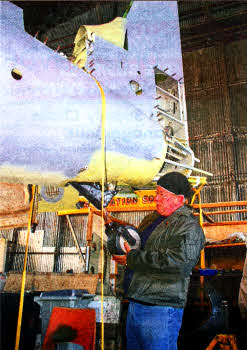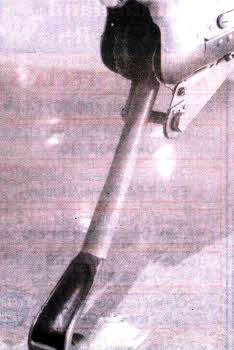
- Lisburn News 2012
- Lisburn News 2011
- Lisburn News 2010
- Lisburn News 2009
- Lisburn News 2008
- Lisburn News 2007
- Lisburn News 2006
- Lisburn News 2005
Search is on for missing 'cat's tail'

UAS member Mal Deeley checks the fit of the Wildcat's tailwheel to the fuselage. The missing tailhook retracts into the extreme end of the aircraft's tail. The pilot would operate a control to drop the device into position for landing aboard an aircraft carrier. (Picture by Stephen Riley)

This is the tailhook, also known as the arresting hook, of the type which has been missing for many years from its parent aircraft, a Grumman Wildcat. (Pic by Sam Davis).
THE Ulster Aviation Society based at the Maze is on the hunt for a "cat's tail' that's been missing for many years.
The arrestor hook is part of the society's vintage Wildcat fighter, and the group's chairman says there is reason to believe it's in someone's home in the Ballynahinch area. "It's an original part of the aircraft, which we're restoring, and wed like to keep as much of the aircraft as original as possible," Mr. Burrows explained.
The Wildcat was ditched in Portmore Lough, near Ballinderry, in 1944 when it ran into engine trouble during a World War II training flight. It sat half-submerged in the shallow lough for 40 years before it was salvaged for the Society's collection.
First, however, the warplane was made safe through the retrieval of its guns and ammunition. It was during that operation that somebody unbolted the tailhook as well, and probably kept it as a souvenir. It's been missing ever since.
"But we had a visit earlier this year from the guy who had taken the ammunition out and he told us his friend took the tailhook off at the time," said Mr. Burrows. "His friend was over the moon, he said, about getting the tailhook. A fantastic bit of engineering,' he said. But we no longer have the name of that visitor or his friend. It's been a folly of errors."
Just what is a tailhook, and what's it for? Simply put, it's a metal
bar, hinged at one end and attached to the lower rear of an aircraft,
with the free end formed into a claw. This bar can be lowered by a pilot
approaching an aircraft carrier; immediately on landing, the pivoted
claw snags a cable stretched across the ship's flight deck from spools
holding each cable-end. The tension on the spools can be adjusted to
compensate for the weight and speed of various aircraft. The cable is
what "reins in" the aircraft and prevents it from speeding off the deck
and into the sea.
The Society sometimes has to build aircraft parts to replace those which
are broken, corroded or simply missing.
"But this tailhook is a forging, and we don't have facilities to do that kind of work," Mr. Burrows explained. "My hope is that it's lying in a corner somewhere, perhaps in someone's garage! The bit of information we do have indicates that it could be in the Ballynahinch area. The fellow who retrieved it has probably passed away by now, but perhaps his son or someone else knows where it is. We're anxious to find it so that this aircraft can assume its place in our collection as a complete and important historical exhibit, and a tribute to the brave pilots who flew it."
Anyone who might have information on the missing tailhook is encouraged to contact Stephen Riley of the UAS at (mobile) 07919 122899 or e-mail: sriley@freezone.co.uk.
Ulster Star
12/10/2012
